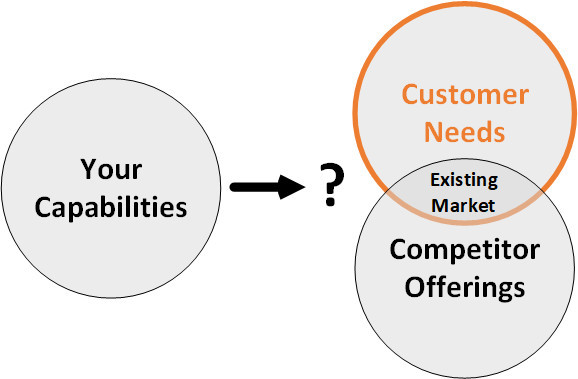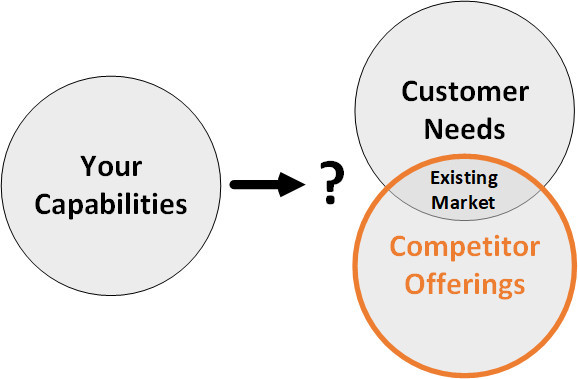It makes a big difference in solving a problem if you ask the right question, and within the right context. This post explores the realm of three distinct contexts in which you could find yourself with projects supporting a high potential growth situation.
Strategy Dynamics and Managing Project Timing in Growth Companies focused on the timing of a high growth commercial industry project. This post focuses on what to do to gain competitive advantage based on the situation and approach to the problem. It gives perspective for setting project metrics to track your project against the right success criteria.
The three contexts explored all rely on invention to create compelling value, and all are dependent on the ability to identify and build a protective moat – leveraging one or more ‘powers’ that give sustainable strategic advantage – around the business as you implement your project.
Most importantly, this post explores the dynamics of competitive strategy – the differences in project implementation, depending upon the context.
Power and Invention in a Growing Business

In his book “7 Powers: The Foundations of Business Strategy”, Hamilton Helmer said: “Power comes on the heels of invention, be it in products, processes, brands, or business models.”
He also opined that most of what people consider to be invention is simply operational excellence, which is good, but by itself offers no strong competitive advantages. Instead of providing a protective moat for the business, it is subject to actions from competitors that result in a stalemate.
True invention, by contrast, opens the door to protected power and can create market growth, leading to greater market size.
Invention varies, not only on its focus – products, processes, brands, business models – but also on what drives it. The diagram to the right shows three main drivers, or sources, of compelling value that the company can create. Each of these are very different in how the business approaches creating the value, and the differences are important in how a supporting project is implemented.
Here is a short description of each of these three main drivers, or sources, for creating compelling value and how they have different tactical needs that are important to project development.
- Capabilities-led compelling value – This is when a company tries to translate some strong capability that it possesses into something of compelling value. It could be a product or the underlying technology, existing well-developed processes, established brands, or proprietary business models – all with a moat in place that can protect the capability from the competition.
- Customer-led compelling value – This occurs when many players spot an unmet need, but not one has yet discovered how to satisfy it. There is a customer need in the form of a problem to be solved, and your company needs to envision a path to solve it in a way that uniquely builds a business moat around the solution.
- Competitor-led compelling value – This happens when the competition has already brought at least partially successful solutions to market, and the inventor must produce something so much better that customers have a red-hot desire to have it. The competitors have discovered the market, but you find a way to leap-frog their offerings.
The ultimate situation is where Customer Needs intersect with Your Capabilities, as identified by the star in the diagram. Note that this excludes the area that also intersects with Competitor Offerings. In that ideal case, your company alone has the solution to the customer’s problem with a protected position.
Let’s take a closer look at the challenges, opportunities, and risks with each in the sections below.
—————————————-
I recommend these PM templates (paid link):
—————————————-
Invention Based on Company Capabilities
 I have always thought of this situation as “a solution in search of a problem.” This somewhat cynical view grew from what I saw in many industrial situations, where in fact there was little flexibility in adjusting a product to fit a situation.
I have always thought of this situation as “a solution in search of a problem.” This somewhat cynical view grew from what I saw in many industrial situations, where in fact there was little flexibility in adjusting a product to fit a situation.
In today’s digital powered era, much more flexibility exists, including the ability to more easily adjust the solution to the problem, or to fine tune targeting of customers – but it’s still a challenging problem to solve.
One challenge is that it is very difficult to frame a project with a clear end point. You really do not know exactly what that project end point will be – that’s the question mark (?) in the diagram at right – except that you will have found a match of your capability to a problem in the market.
Timing is another issue. Getting to this unclear end point can take considerable time – often years. The project will require substantial commitment and staying power to stay in the game that long. Identifying some mileposts – some measurable small victories – along the way can help. In addition, at the starting point for the project, it is important to know that the capability is unique in some way and cannot be easily replicated. It is well protected by one or more competitive barriers – which can provide some optimism and staying power.
Funding can also be a major challenge. Since there is a risk of losing stakeholder support because of the uncertainty and long time frame, running out of funding would naturally follow. Ensuring good funding from the start, being judicious in spending by avoiding large commitments, and cultivating stakeholders with patience – and “patient money” – will be key to success.
Invention Based on Customer Needs
 Here we have a different path to compelling value. A need is out there – most likely known widely by many competitors. Your company’s possible solutions must be considered not only for their efficacy with the customers, but for the potential to build protective barriers, or ‘powers’.
Here we have a different path to compelling value. A need is out there – most likely known widely by many competitors. Your company’s possible solutions must be considered not only for their efficacy with the customers, but for the potential to build protective barriers, or ‘powers’.
One consideration is which aspect of the business – products, processes, brands, business models – does the action (for example, project) touch? It could be one – or more of these aspects.
The first question to consider carefully is, “Do we intimately understand the Customer Needs?” Then, assuming the answer is “Yes!”, the second question to consider is of a technical nature: “Can we invent what will fill the Customer Needs?”
When considering these questions, it is foremost to constantly consider the potential your company has to build defenses against its potential position. Each course of action needs to be evaluated against the potential to build defenses. This is important when building the project portfolio, as well as during project implementation. Sometimes a pivot is necessary to keep the project on track to achieve appropriate defenses.
Invention Based on Competitor Offerings

This situation has a whole different set of challenges than those above. There is a market where competitive offerings already exist, but for which your company thinks has or can build a solution with more compelling value.
The first consideration is, “How much compelling value can you create?” Your solution needs to be an order of magnitude greater – incremental improvement is not enough – than that of existing competitors to get customers excited and strongly desiring your solution. The magnitude of the difference will vary, depending upon the situation.
Another consideration is that since there are competitive offerings, you will likely have to make a substantial commitment up front – a big bet. This is fraught with risks, but it is probably required in this context.
Not only must you make a substantial commitment up front on your own internal efforts, but you will probably need to make some commitments to partners on the project. This could be suppliers, service providers, and entities that are part of the ecosystem that you need in order to execute.
The Dynamics of Competitive Strategy: What Projects To Do, and How to Measure Success
Projects need to be selected on the basis of which core company capabilities can be leveraged, what customer needs are going unmet that you might have a chance to fill, and the probability for ‘inventing’ a better solution – disruptive, not just incremental – where competitors are already established.
In each of the three situations considered in this post – where the compelling value to be invented is based on Your Capabilities, Customer Needs, or Competitor Offerings – requires an implementation that acknowledges unique risks in terms of investment, commitments, tactics, and timing.
Starting from your specific context, you must select relevant metrics that must address these risks, track them throughout project implementation, and be ready to pivot, especially if that is required to achieve the power needed to achieve a protected position.
To learn more about the dynamics of competitive strategy, you can purchase “7 Powers: The Foundations of Business Strategy” by Hamilton Helmer as follows:
- Hard cover book: 7 Powers: The Foundations of Business Strategy
- Audio book: 7 Powers: The Foundations of Business Strategy
- Kindle book: 7 Powers: The Foundations of Business Strategy
—————————————-
I recommend these strategy resources (paid link):
—————————————-

